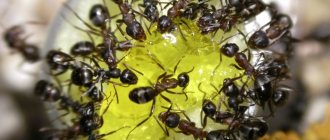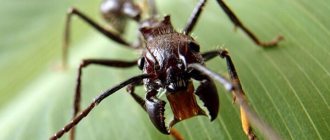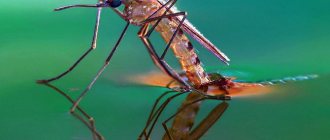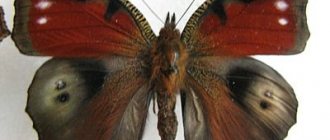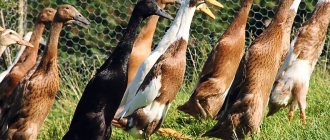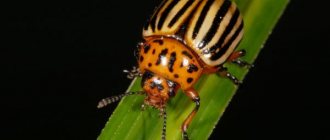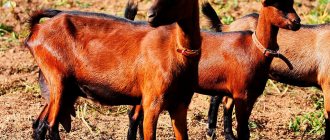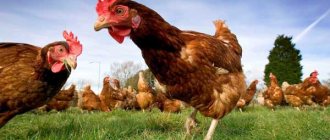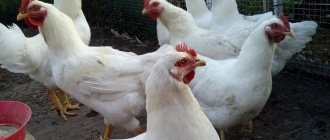Private houses and city apartments are increasingly becoming habitats for ants. They come to human habitation in search of an inexhaustible source of food and warmth. The presence of such a place allows insects not to think about wintering, not to hibernate during cold weather, and to always have food.
Optimal living conditions for ants are high humidity and a temperature of about 20°C -30°C. For food, they prefer to consume sweet drinks, crumbs from flour products, cereals, fruits and other dishes that are publicly available in the apartment.
The house can be favored by red, black and yellow ants. If one or more single individuals are found in an apartment, you should immediately take measures to destroy them. The peculiarities of their lifestyle, physiology and reproduction complicate the process of fighting insects. For the process to be effective and to obtain the expected result, you need to know how to find the queen of a colony, clusters of individuals and a nest of ants in an apartment. This is usually a hard-to-reach, dark, warm and damp place in the kitchen, bathroom or bathroom. You should carefully inspect the openings in the walls for sockets and switches, the space between the tiles and under the baseboard, cracks and holes in the wooden floor.
Often the nest is located not in the apartment itself, but between floors. If the ant population has become large enough, they begin to expand their habitat into neighboring rooms. Specialized teams equipped with professional equipment will help destroy insects in interfloor ceilings.
Helpful advice
Passive observation is often the most effective way to detect insects in an apartment. Study the direction where insects take food. If they go into holes, then silicone sealant will help cut off their path to the food source.
The role of the queen in the anthill
The queen does not work like other ants, does not protect the colony, does not look for building materials or food, she has a more important role - laying eggs. From them new individuals then appear, which take the place of ordinary workers. The queen is a special female in an anthill who has the ability to lay eggs. There are other females in the colony, but they do not give birth to “offspring”, but perform the same functions as other members of the community.
All ants serve the anthill and their queen, without whom they will die
The queen is the center of the universe for ants. Experience has shown that a colony will die in a matter of weeks if something happens to their queen. Knowing this, you can get rid of annoying “neighbors” in the house.
If the colony is very large (mainly in natural conditions), then there may be several queens. This is called polygyny. Queens lay eggs, they are given the same “care”, there is no preference for one queen over another. Therefore, if you decide to destroy an anthill, depriving it of its queen, but for some reason the colony remains in the same place, this means that there are several queens there.
In large ant colonies there may be several queens
Can an “ordinary” ant become a queen?
Primitive ant species do not have a queen, but have several females that can lay eggs. They act as a queen, but live as long as their counterparts. This means that the duration of the genus of this particular colony directly depends on the short life of the females: if all the egg-laying ants disappear, the anthill will be doomed to death.
A simple worker ant cannot become a queen
The queen lives 100 times longer than an ordinary ant (on average up to 15 years) and produces offspring of the colony for many years.
An ordinary ant cannot become a queen, it can only temporarily perform her functions, but a colony without a queen is obviously doomed to extinction.
Is the queen really the boss in the anthill?
The queen lives in the very depths of the anthill, so other living creatures, as a rule, cannot reach her, and some natural “disasters” (something fell from above, a strong wind blew and the ant was carried away, etc.) it is practically not affected. Throughout her entire life (and this is up to two decades), she does nothing but give birth to offspring. 90 or more generations may take place, and the queen will be alone and will lay eggs just as efficiently as in the first time after fertilization. Therefore, of course, the ant queen is the most important, significant unit of the entire ant kingdom.
Flood and fire are those natural disasters that can really destroy the queen ant
Soldier Ants
Anthill defenders are a subspecies of the worker ant, but with slightly larger dimensions. Some ant species have insect soldiers that are unable to feed on their own. The workers are forced to feed them.
The main function of a soldier is protective. It protects the anthill, food supplies and foraging ants. A secondary task is to help dismember large prey into pieces if the worker ant is not able to carry it away entirely.
What does a queen ant look like?
It is very simple to distinguish the queen ant from simple “hard workers”: it is larger in size, thicker, so to speak. The queen has a large abdomen, on which the oviparous organ is located (in house ants, the abdomen measures 3–4 mm). The queen also has massive breasts that are no smaller than her head. This is explained by the fact that initially, before the breeding season, the female had wings, so the muscles in this area are large and strong.
The queen ant is always larger than the “ordinary” ants
The queen is less mobile and agile than an ordinary ant, since she only gives birth to offspring.
Stages of development
Ants are insects that have a complete transformation cycle. The whole process is divided into several stages.
Egg
After the female has completed her mating flight, found a place and created a nest, she begins to lay eggs. They look like this:
- small, length no more than 1 millimeter;
- oval shape;
- have a white or yellow tint (depending on the type of ant).
Workers care for the eggs. Their responsibilities at this stage include:
- brood sorting;
- finding optimal conditions for development.
Larva
After (the time depends on the type of ant and living conditions), larvae are born. Outwardly, they look more like worms than ants.
First, the larvae are located together in a “package”. As they grow older, they live separately.
At this stage, increased nutrition of the future ant occurs. The same worker ants take care of food. Their responsibilities include obtaining food and timely delivery.
The larvae do not excrete.
Doll
Between the larva and the adult insect there is another stage - the pupa. In some species it may be absent. The process is called "incomplete transformation".
During the pupal stage, the larvae stop feeding, they excrete feces and spin a cocoon. In rare cases, future ants refuse the cocoon. This is due to the peculiarity of the species.
Imago
The last stage in the formation of an ant. The imago, or in other words, an adult insect, emerges from its cocoon (if there was one). The young ant cannot get rid of it on its own. Relatives, in particular workers, are involved in the exit process. They pull the ant out of the cocoon.
At this stage, the young insect has:
- light color (the shade becomes dark after 3-5 days);
- the ant does not grow;
- eats foods rich in carbohydrates.
The life of a queen from birth to the founding of her colony
There are always a lot of both males and females in colonies, but not all “females” are capable of fertilization. Those of them that can produce offspring mate with the opposite sex in the summer, after which they either return to the mother colony (if they are red ants) or go in search of a good place to found their settlement. They move not so far from their place of birth and subsequently “keep in touch” with their first anthill.
If an ant was born female, this does not mean that it will live long and is a queen
The future queen is looking for a place for her kingdom using her wings. After she has decided on the location, the female lays the first eggs and sheds her wings or chews them off. The queen does not look for food for her offspring, but feeds them either with eggs specially laid for this purpose, or with fat reserves and deteriorating wing muscles.
Ant queens mate only once in their lives, after which the female spends the resulting supply of sperm throughout the remaining years.
The uterus itself controls how many and what kind of individuals it “gives birth to”
It is quite difficult to say in advance whether a female is a queen, because this is determined not only by her ability to reproduce, but also by her life expectancy. If she lives longer than an ordinary ant, then she is a queen, if not, then she was not one.
The queen rarely eats herself: there are special “court” ants that pre-chew food and then give it to the queen. Such food is easier and faster to digest, which is exactly what is needed for the one on which the well-being of the entire colony depends. It feeds mainly on protein foods.
Parasitism on other colonies
All ants, with the exception of one species, either create their own colonies in a new place, or live with their “mother”. Only Formicoxenus Nitidulus climb into someone else's anthill and live there happily. Of course, the “guards” “grab” them, but that’s where the matter ends. Scientists suggest that Formicoxenus Nitidulus secrete a secret that repels other ants. The queen of such parasites can quite easily settle in any other anthill and create her offspring there.
Formicoxenus Nitidulus parasitize on foreign colonies
Video: Queen ant lays eggs
External characteristics: what are the features
The queen occupies the main place in the anthill and is located in the central part of the nest. It is the queen who is responsible for creating offspring and increasing the number of insects.
Black and orange ants have only one queen. The female does not take part in obtaining food. Doesn't leave the nest. The only goal is reproduction. The queen and the younger generation are looked after by workers.
House red ants can have a pair of queens. Females do not conflict with each other.
The female differs from working ants in size and body structure. The main females are twice as large as the others. They grow 4-4.5 cm in length, less often even more. The chest is wider due to the presence of flight muscles. The body is dark brown. The belly is lighter.
Due to its size, the uterus is less agile. Relatively motionless. The female practically never leaves the nest. Eats food brought by workers. Initially, the uterus has wings. This part of the body falls off when a colony forms on its own, or the female gnaws them off herself. This is a kind of additional food.
The queen constantly lays eggs
Unlike male representatives, the uterus emerges from fertilized eggs. Sometimes queens leave the nest and move to a new location to create another colony.
What happens if the uterus dies
As practice shows, it is impossible to say for sure what will happen if the uterus is destroyed. If she had brood when you caught her, then there is a high probability that the colony will soon die. If she recently laid eggs, then there is a possibility that among the new individuals there will be either a female or a full-fledged uterus, which will continue to produce offspring.
If you leave only the queen alive, she will revive the anthill, and if you kill only the queen, then there is a high probability that the colony will die
The lifespan of an ant depends on what species it belongs to. If we are talking about domestic (pharaoh) insects, then the male lives only 20 days, and the working individual lives 60 days. Therefore, if the queen did not leave new offspring, then the ants will die in less than 2 months.
If the queen dies in the incubator
Ants must be properly cared for; they should not be released into the formicarium ahead of time. The smaller the colony and the larger the space for it, the higher the likelihood that the ants will spread garbage throughout the incubator, which will cause mold and other “joys” to appear that will destroy the community and the queen as well. If you followed all the rules for breeding ants, but the queen still died, you must either wait to see if she left another female in her place, but in this case the colony may disappear, or acquire a new queen.
Ants should be bred very carefully and carefully, otherwise it is easy to destroy the entire colony
Personal experience says that the queen must be of the same species as the entire colony, otherwise the ants will not accept her and will kill her.
Genetics
After conducting genetic studies of ants, scientists concluded that insect genes contain more than 600 individual DNA sections. Most of them are responsible for social behavior. A gene has also been found that is responsible for how many females will live in the clan. Those. only born ants know what their duties are.
Typically, the gene pool is subject to mixing. One exception is the cloning process. It happens in nature that in fertilized eggs all the mother’s chromosomes are destroyed and, as a result, males appear.
Where to find a queen to get rid of house ants
House ant nests are usually located in secret places. First you need to determine where the insects come from. To do this, you can monitor the movement of worker ants. However, it also happens that there is a network of diffuse nests located in different places, between which communication is maintained, and the uterus can be located in any of them. In this case, there is very little chance of finding the queen ant.
The queen lives very deep in the anthill so that no enemies can reach her. And it is almost impossible to lure her out. You can try to arrange some kind of small apocalypse so that the insects' instinct of self-preservation will work (for example, blow on an ant's nest with a hairdryer or fan). However, in the flow of ants it will be difficult to pull out the uterus. Therefore, it is necessary to search in the colony itself and pull the queen out of there. In exactly the same way, you need to get the queen of ants in natural conditions (in nature). It is quite easy to destroy it - insects do not survive in boiling water or under heavy loads.
Using aerosols it is easy to treat vertical or inclined surfaces where ants hide
As practice shows, catching and immediately destroying the queen is not always effective, since most often she is caught after she has laid eggs. To kill both the queen and the offspring, it is necessary to place products mixed with a slow-acting poison in the “visibility zone” of insects. It will accumulate in the body of the uterus for a long time, and as a result will destroy both it and the eggs. You should not rely only on folk remedies; special gels, aerosols and traps against ants are effective.
Ants' Strength and Endurance
They say about some people: “Works like an ant.” And it does not mean that the result of his work is microscopic. On the contrary, it is praise denoting a gigantic job done alone. The comparison with insects is not accidental. Few in the animal world can boast of such strength and endurance. The little ant is able to lift and carry weight 50 times its own! And if several insects join forces, the number increases to 70-80! This is because the ant's body structure is dominated by muscle tissue. Considering the size of the anthill and the number of “freeloaders” that the worker ant provides with food, it is clear that it is not at all superfluous in strength. A stubborn insect, if unable to lift and carry large prey, will drag it along the ground behind it until help arrives.
Surprisingly, when an obstacle appears on the way, the ants cling together with their paws and form living bridges up to several meters long. This is usually necessary to overcome a stream, a crevice, or any place where it is not possible to walk on the ground. So, such a bridge can withstand a load of several kg.
